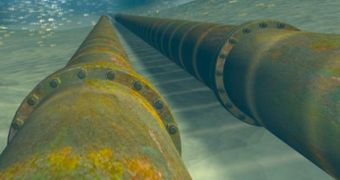Back in 2006, the Researcher Council of Norway, together with a bunch of oil companies, agreed to pump $25 million (€18.5 million) into a project dubbed SmartPipe. The goal was to create a new generation of pipelines that were able to tell when something was wrong, and alert workers before things got out of hand.
Apparently, the $25 million was money well spent. Thus, SINTEF researchers have come up with an innovative concept for a system that would make it possible to monitor pipelines carrying hot well stream in real time and ensure that spill risk is kept at a minimum.
Long story short, the idea is to fit pipelines with sensor belts that keep tabs on temperature, vibration, acceleration, wall thickness and tension. Information collected in this manner would be transmitted either to a platform or onshore.
Should either of said parameters go bananas for one reason or another, workers would be able to act quickly to solve the problem and keep disasters from happening.
“Today, all pipeline status monitoring is based on regulations. Everything is based on safety guidelines and five-yearly inspections. The new self-monitoring pipelines provide us with a continuous data stream and will allow us to maintain the condition of a pipeline in an entirely different way, enabling us to respond to problems at an early stage,” says Ole Øystein Knudsen with SINTEF.
“Another important issue is the monitoring of unsupported sections along a pipeline. These sections may start to swing and incur fatigue fractures due to the undulating sea floor, but the new pipes will enable us to prevent this situation,” he adds.
Should this system be implemented on a global scale, folks in the oil industry will be quite happy that no precious money-making resources are lost, and marine creatures will be jumping for joy at the thought that they no longer have to pay hefty sums for spill insurance.
A 250-meter such pipeline is set to soon be tested in the waters off Norway. Researchers working on this project hope to determine whether or not the concept is viable, and if the proposed system would be as impressive in real life as it is on paper.

 14 DAY TRIAL //
14 DAY TRIAL //